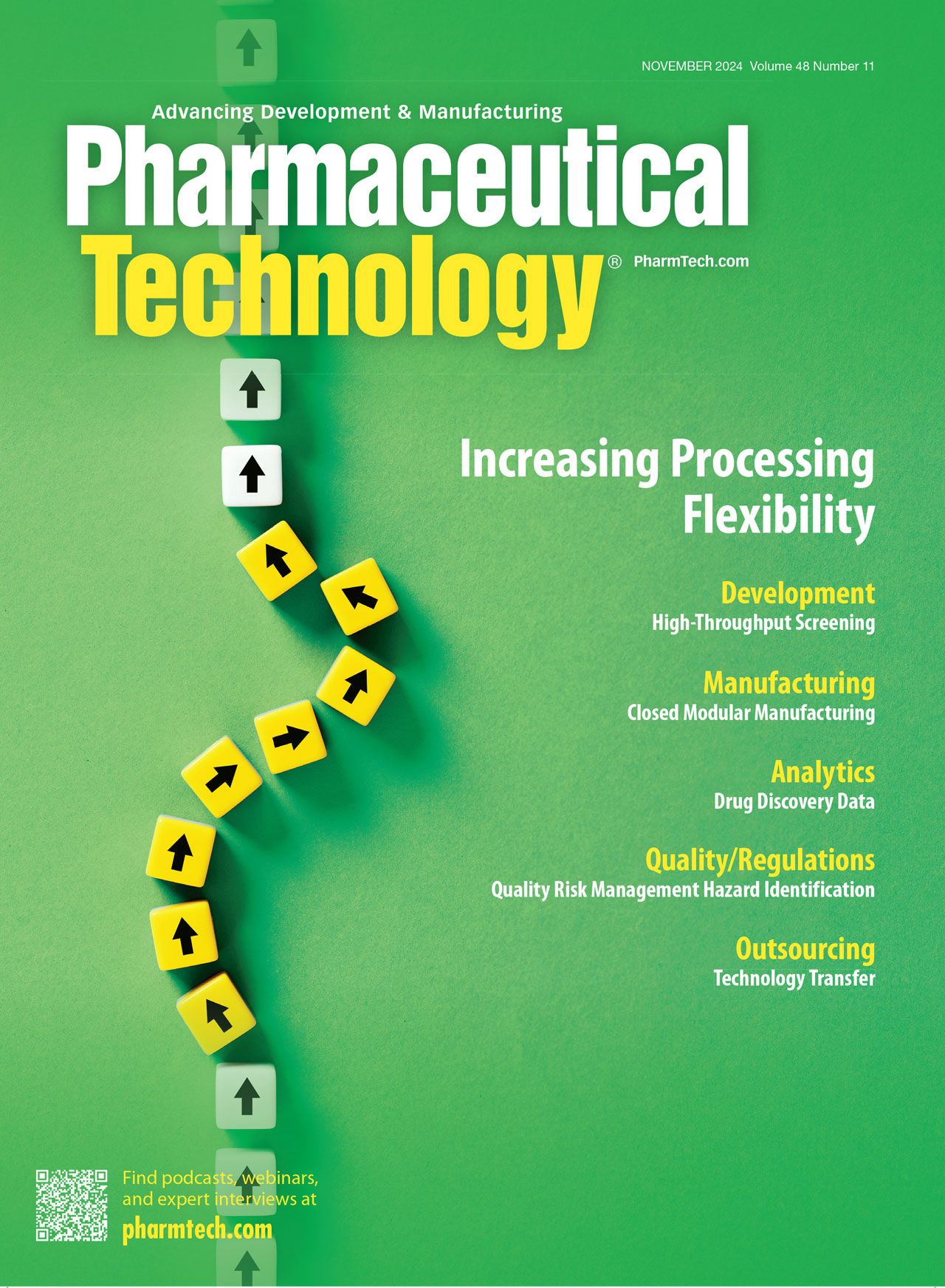Strategies for Overcoming Common Challenges in Tech Transfer
The complexities of tech transfer may be overcome by data-driven approaches, digital tools, and effective communication.
Man touching a knowledge sharing concept | Image Credit: ©thodonal - stock.adobe.com

Outsourcing in the biopharma and pharma industries is on the rise, driven by increasing competition, the rising number of emerging start-ups, and the demand for affordable medicines. While outsourcing offers numerous advantages, including access to specialized facilities and expertise, technology transfer remains a critical challenge.
Common hurdles in the complex nature of tech transfer may be overcome by data-driven approaches, digital tools, and effective communication.By embracing these strategies and collaborating with experienced contract development and manufacturing organizations (CDMOs), companies can navigate the complexities of tech transfer and bring innovative therapies to market faster.
Common technology transfer challenges
The increasing complexity and cost of drug development, coupled with intensifying market competition and the demand for faster time-to-market, have driven a significant rise in outsourcing within the biopharmaceutical industry during the past 10 to 15 years (1).
As of 2023, over 60% of biopharma companies outsource at least some activities, contributing to the remarkable growth of the CDMO market, which is projected to outpace overall pharmaceutical industry growth through 2028 (2,3). This surge in outsourcing is fueled by factors such as the need for specialized expertise and infrastructure, the rise of resource-constrained start-ups, and the pressure to deliver affordable therapies.
While outsourcing to CDMO partners provides many advantages for pharma and biopharma companies, such as helping to mitigate risks and accelerate development timelines, a critical phase in the process can pose significant challenges: technology transfer. Seamless tech transfer ensures that the manufacturing process is faithfully replicated at the receiving site, safeguarding product quality, maintaining regulatory compliance, and minimizing the risk of costly delays or disruptions. However, this process is far from a simple exchange of physical assets; it involves the intricate transmission of knowledge and expertise required to replicate a complex manufacturing process.
Common tech transfer challenges include the following:
Misaligned expectations and project scope definitions. The drug developer or marketing authorization holder (MAH) may have preconceptions about their product based on initial information. These assumptions can influence the project plan and the tech transfer process itself. If these initial assumptions prove inaccurate, it can lead to costly delays and rework. Common examples of such discrepancies include unexpected product stability issues arising from changes in analytical methods, necessary product modifications to comply with evolving regulations (e.g., nitrosamine or elemental impurities guidelines), or misinterpretations of regulatory requirements at the project’s outset.
Product knowledge gaps. Effective technology transfer hinges on a comprehensive understanding of the product and its manufacturing process. However, there can be gaps in technical knowledge that may hinder the creation of a robust transfer process, particularly with legacy products or those in early development stages. Some originating sites may lack experience in tech transfer, leading to uncertainties about the necessary information or its sources. Additionally, inadequate documentation practices can result in the loss of valuable technical knowledge, potentially leading to repeated challenges and delays during the transfer, impacting project timelines.
A lack of standardization at the receiving site. Challenges can arise during tech transfer without standardized internal processes and documentation at the receiving CDMO site. Multiple tech transfers from diverse clients with varying requirements can lead to inconsistencies, potentially impacting project timelines and efficiency. Implementing standardized procedures and documentation across projects streamlines the tech transfer process, enhancing productivity and fostering operational excellence. This ensures a smoother transition, regardless of the client or project complexity, and ultimately benefits both the CDMO and its partners.
The absence of dedicated teams. Effective tech transfer management and coordination rely on assembling dedicated teams at both the originating and receiving sites. However, this can be challenging, especially for smaller organizations or those with limited experience in tech transfer. The originating site may lack personnel with specialized knowledge in handling the transfer process, requiring additional support in gathering and organizing the necessary information for handover. Similarly, the receiving site may need to tap into expertise beyond its core tech transfer team for complex or novel projects. This ensures the development of a comprehensive and tailored plan that addresses the unique challenges of the specific technology being transferred.
Failure to address these challenges and navigate tech transfer effectively can have far-reaching consequences, impacting the overall success of the end product and potentially hindering its timely delivery to patients. Pharma and biopharma companies should always look closely at the tech transfer processes and capabilities of a potential partner when selecting a CDMO, ensuring that the right strategies are employed to successfully develop and manufacture their therapy.
Strategies for an efficient and effective tech transfer
Experienced CDMOs will employ a range of proactive strategies to ensure a seamless and successful tech transfer process while simultaneously mitigating risks to streamline timelines.
Statistical modeling for tech transfer. A dedicated team of data scientists and statisticians equipped with advanced modeling and statistical tools can significantly enhance the tech transfer process. By harnessing the power of data-driven insights, development timelines can be accelerated, API consumption optimized, and tech transfers de-risked, leading to consistent, high-quality results throughout the manufacturing process.
Statistical modeling has emerged as a powerful tool for mitigating risks and ensuring a seamless transition throughout tech transfer. Harnessing a holistic, integrated approach to modeling across the drug development lifecycle, unlike standard processes which often focus on isolated aspects, drug developers can gain a comprehensive understanding of the product and its manufacturing process, allowing for confident decision-making and proactive risk mitigation.
Through the creation of sophisticated predictive models, developers and manufacturers can establish clear connections between material attributes, process parameters, and critical quality attributes (CQAs) of the drug product. Using a broad range of data sources information, including data from specialized equipment such as those used for powder characterization and simulation, historical data from previous projects, literature data, and real-time process data, developers can generate more robust and comprehensive models with enhanced predictive accuracy. This enables the identification of key process parameters that significantly impact product quality, empowering targeted optimization and control during tech transfer.
Predictive modeling capabilities also allow for the simulation of process performance under various conditions, aiding in the selection of optimal operating parameters and anticipating potential challenges during scale-up. This foresight minimizes the risk of costly deviations or failures, ensuring a smoother and more efficient transfer process.
By defining the “design space”—the range of operating conditions where product quality is assured—statistical models provide a clear framework for process transfer and robust control strategies. This data-driven approach reduces reliance on empirical methods, fostering a more predictable and reliable tech transfer process.
Digital tools improving connectivity. In addition to statistical modeling, technological advancements are also revolutionizing the way tech transfer is conducted, offering innovative solutions to address issues surrounding data flow and connectivity. Traditionally, data flow during tech transfer has involved cumbersome processes, relying heavily on the physical transfer of documents, spreadsheets, and presentations, coupled with in-person meetings and limited digital communication. This approach presents challenges in terms of efficiency, security, and version control, often leading to delays and potential misinterpretations.
Traditional methods of data storage and transfer are now being replaced by advanced digital knowledge management systems. These systems enable automated information capture and ensure centralized storage of all relevant data, promoting efficient and transparent information sharing between the originating and receiving sites. By standardizing data organization and facilitating seamless transfer between systems, these tools significantly expedite the tech transfer process, saving valuable time and resources.
Digital tools also play a crucial role in overcoming geographical barriers. Video conferencing and project management platforms enable real-time communication and collaboration, even when teams are located in different parts of the world. This enhances transparency, fosters effective teamwork, and ensures that all parties are aligned throughout the tech transfer journey.
A foundation of transparency and collaboration. Open communication and transparent information exchange are pivotal for achieving seamless technology transfer. At the onset of the process, it is essential to share comprehensive process documentation, encompassing not only successful runs but also any documented failures or challenges encountered at the originating site. This complete picture empowers the receiving site to anticipate potential hurdles and proactively implement preventive measures, minimizing the risk of delays and ensuring a smoother transition.
Providing opportunities for the technical team from the receiving site to observe processes at the originating site can significantly enhance understanding and facilitate the transfer of tacit knowledge. Similarly, conducting engineering runs under the observation of peers from the sending unit allows for real-time feedback and validation, ensuring that the process is accurately replicated, and any undocumented nuances are captured and shared.
Established tech transfer process methodology. The receiving site must have defined and established processes for tech transfer projects. These should include predefined project phases with clear milestones and deliverables pivotal for achieving an efficient tech transfer process and establishing a robust production system. A clear gate system between project phases allows developers and manufacturers to access the transfer process in each phase of the transfer and ensure that deliverables with the required quality are achieved. Leveraging a gate system, developers and manufacturers can identify and quickly address any gaps in the tech transfer process, enabling efficient and rapid production process transfer to the receiving site. Clearly defined roles, responsibilities, and deliverables for each step further enhance the efficiency of the tech transfer system.
Tech transfer in the era of accelerated development
As the biopharma and pharma industries continue to rapidly evolve, the demand for swift and efficient tech transfers will only intensify. The pressures to bring innovative therapies to market faster, coupled with the increasing complexity of drug development, necessitate a proactive and adaptive approach to technology transfer. Embracing data-driven strategies, leveraging digital tools and advanced modeling, and fostering a culture of transparency and collaboration will be essential for success in this new era.
By working in partnership with experienced CDMOs that harness these strategies, biopharma and pharma companies can navigate the intricacies of tech transfer with confidence, ensuring that their innovative products continue to reach patients swiftly and safely.
References
- Khanna, S. 2022 Outsourcing Trends in Biopharmaceutical Manufacturing. OutsourcedPharma.com. June 15, 2022.
- BioPlan Associates. 20th Annual Report and Survey of Biopharmaceutical Capacity and Production (BioPlan Associates, Inc. April 2023).
- Kansteiner, F. 2024 Forecast: As CDMOs Come Off Pandemic’s Highs and Lows, Employment and Funding Hitches Persist. Fierce Pharma. Jan. 8, 2024.
About the author
Radoslaw Kaczanowski is head of Global Project Management at Recipharm.
Article details
Pharmaceutical Technology®
Vol. 48, No. 11
November 2024
Pages: 31–33
Citation
When referring to this article, please cite it as Kaczanowski, R. Strategies for Overcoming Common Challenges in Tech Transfer. Pharmaceutical Technology 2024 48 (11) pp. 31-33.

Drug Solutions Podcast: A Closer Look at mRNA in Oncology and Vaccines
April 30th 2024In this episode fo the Drug Solutions Podcast, etherna’s vice-president of Technology and Innovation, Stefaan De Koker, discusses the merits and challenges of using mRNA as the foundation for therapeutics in oncology as well as for vaccines.